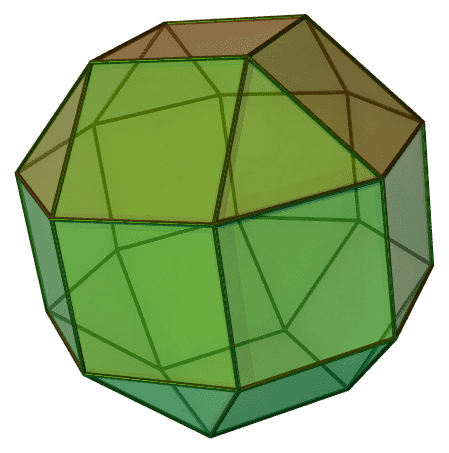 | ||
In geometry, a Johnson solid is a strictly convex polyhedron, which is not uniform (i.e., not a Platonic solid, Archimedean solid, prism or antiprism), and each face of which is a regular polygon. There is no requirement that each face must be the same polygon, or that the same polygons join around each vertex. An example of a Johnson solid is the square-based pyramid with equilateral sides (J1); it has 1 square face and 4 triangular faces.
Contents
- Names
- Pyramids
- Cupol and rotunda
- Elongated and gyroelongated pyramids
- Bipyramids
- Bicupol
- Gyroelongated bicupol cupola rotunda and birotunda
- Snub antiprisms
- Triangle faced Johnson solids
- Triangle and square faced Johnson solids
- Triangle and pentagonal faced Johnson solids
- Triangle square and hexagonal faced Johnson solids
- Triangle square and octagonal faced Johnson solids
- Circumscribable Johnson solids
- References
As in any strictly convex solid, at least three faces meet at every vertex, and the total of their angles is less than 360 degrees. Since a regular polygon has angles at least 60 degrees, it follows that at most five faces meet at any vertex. The pentagonal pyramid (J2) is an example that actually has a degree-5 vertex.
Although there is no obvious restriction that any given regular polygon cannot be a face of a Johnson solid, it turns out that the faces of Johnson solids always have 3, 4, 5, 6, 8, or 10 sides.
In 1966, Norman Johnson published a list which included all 92 solids, and gave them their names and numbers. He did not prove that there were only 92, but he did conjecture that there were no others. Victor Zalgaller in 1969 proved that Johnson's list was complete.
Of the Johnson solids, the elongated square gyrobicupola (J37), also called the pseudorhombicuboctahedron, is unique in being locally vertex-uniform: there are 4 faces at each vertex, and their arrangement is always the same: 3 squares and 1 triangle. However, it is not vertex-transitive, as it has different isometry at different vertices, making it a Johnson solid rather than an Archimedean solid.
Names
The naming of Johnson Solids follows a flexible & precise descriptive formula, such that many solids can be named in different ways without compromising their accuracy as a description. Most Johnson solids can be constructed from the first few (pyramids, cupolae, and rotunda), together with the Platonic and Archimedean solids, prisms, and antiprisms; the centre of a particular solid's name will reflect these ingredients. From there, a series of prefixes are attached to the word to indicate additions, rotations and transformations:
The last three operations — augmentation, diminution, and gyration — can be performed multiple times certain large solids. Bi- & Tri- indicate a double and treble operation respectively. For example, a bigyrate solid has two rotated cupolae, and a tridiminished solid has three removed pyramids or cupolae.
In in certain large solids, a distinction is made between solids where altered faces are parallel and solids where altered faces are oblique. Para- indicates the former, that the solid in question has altered parallel faces, and Meta- the latter, altered oblique faces. For example, a parabiaugmented solid has had two parallel faces augmented, and a metabigyrate solid has had 2 oblique faces gyrated.
The last few Johnson solids have names based on certain polygon complexes from which they are assembled. These names are defined by Johnson with the following nomenclature:
Pyramids
The first two Johnson solids, J1 and J2, are pyramids. The triangular pyramid is the regular tetrahedron, so it is not a Johnson solid.
Cupolæ and rotunda
The next four Johnson solids are three cupolae and one rotunda. They represent sections of uniform polyhedra.
Elongated and gyroelongated pyramids
The next five Johnson solids are elongated and gyroelongated pyramids. These represent the composite or augmentation of two polyhedra. In the gyroelongated triangular pyramid, three pairs of adjacent triangles are coplanar and form non-square rhombi, so it is not a Johnson solid.
Bipyramids
The next six Johnson solids are bipyramids, elongated bipyramids, and gyroelongated bipyramids:
Bicupolæ
The triangular gyrobicupola is a semiregular polyhedron (in this case an Archimedean solid), so it is not a Johnson solid.
Gyroelongated bicupolæ, cupola-rotunda, and birotunda
These Johnson solids have 2 chiral forms.
Snub antiprisms
The snub antiprisms can be constructed as an alternation of a truncated antiprism. Two are Johnson solids, one is a regular, and the rest can not be constructed with regular triangles.
Triangle-faced Johnson solids
Five Johnson solids are deltahedra, with all equilateral triangle faces:
Triangle and square-faced Johnson solids
Twenty four Johnson solids have only triangle or square faces:
Triangle and pentagonal-faced Johnson solids
Eleven Johnson solids have only triangle and pentagonal faces:
Triangle, square and hexagonal-faced Johnson solids
Eight Johnson solids have only triangle, square and hexagonal faces:
Triangle, square and octagonal-faced Johnson solids
Five Johnson solids have only triangle, square and octagonal faces:
Circumscribable Johnson solids
25 of the Johnson solids have vertices that exist on the surface of a sphere: 1-6,11,19,27,34,37,62,63,72-83. All of them can be seen to be related to a regular or uniform polyhedron by gyration, diminishment, or dissection.
